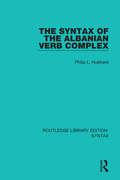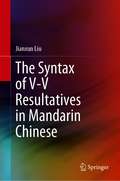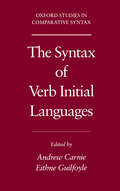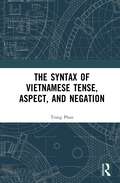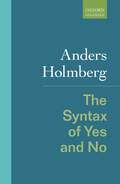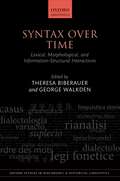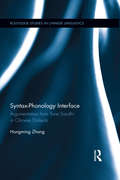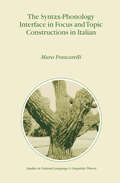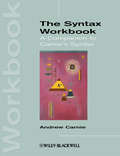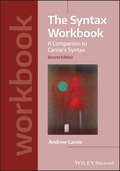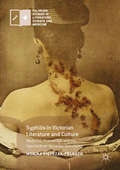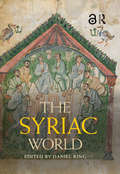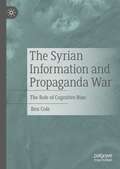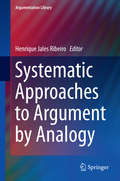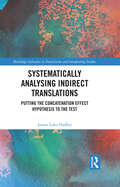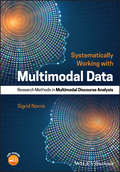- Table View
- List View
The Syntax of the Albanian Verb Complex (Routledge Library Editions: Syntax)
by Philip L. HubbardThis work, first published in 1985, is an analysis of the syntax of the Albanian verb complex. The term "verb complex" is defined here as the verb stem and its conjugational endings, together with the perfect auxiliaries and verb clitics. In a wider sense the verb includes the verb and its central arguments: subject, direct object, and indirect object. The analysis is presented in a somewhat expanded version of the relational grammar framework of Perlmutter and Postal (1977). It is argued that by assuming the existence of multiple levels in the syntactic structure of a clause, it is possible to account for the distribution of active and non-active verb forms over the various constructions of Albanian with a single generalisation. This title will be of interest to students of language and linguistics.
The Syntax of the Albanian Verb Complex (Routledge Library Editions: Syntax)
by Philip L. HubbardThis work, first published in 1985, is an analysis of the syntax of the Albanian verb complex. The term "verb complex" is defined here as the verb stem and its conjugational endings, together with the perfect auxiliaries and verb clitics. In a wider sense the verb includes the verb and its central arguments: subject, direct object, and indirect object. The analysis is presented in a somewhat expanded version of the relational grammar framework of Perlmutter and Postal (1977). It is argued that by assuming the existence of multiple levels in the syntactic structure of a clause, it is possible to account for the distribution of active and non-active verb forms over the various constructions of Albanian with a single generalisation. This title will be of interest to students of language and linguistics.
The Syntax of V-V Resultatives in Mandarin Chinese
by Jianxun LiuThis book addresses the three fundamental properties of V-V resultative constructions in Mandarin Chinese: their generation, their syntactic structure, and their alternations. This book is original and new in the following aspects. First, adopting the ‘inner vs. outer domain’ theory, it provides new analysis and evidence that these compounds are generated in syntax, not in lexicon. Second, this book argues that the two subclasses of V-V resultative constructions, object-oriented vs. subject-oriented V-V resultatives, actually have different structures. Their syntactic contrasts have not been observed in the literature before. Third, this book is new in determining the syntactic structure of the V-V resultative constructions through their adverbial modification properties. It demonstrates that the previous isomorphism analysis of the syntactic structure of Chinese V-V resultatives does not hold. Finally, this book provides a new analysis of the issue of the alternations of V-V resultatives. In contrast to previous analyses, which generally view the causative alternation as the idiosyncratic property of particular V-V compounds, this book provides a principled analysis. This book makes a substantial improvement of the current understanding of the issues in the syntax of Mandarin Chinese and gives new support to certain theories of the generative grammar from the perspective of Mandarin Chinese.
The Syntax of Verb Initial Languages (Oxford Studies in Comparative Syntax)
by Andrew Carnie Eithne GuilfoyleThis volume contains twelve chapters on the derivation of and the correlates to verb initial word order. The studies in this volume cover such widely divergent languages as Irish, Welsh, Scots Gaelic, Old Irish, Biblical Hebrew, Jakaltek, Mam, Lummi (Straits Salish), Niuean, Malagasy, Palauan, K'echi', and Zapotec, from a wide variety of theoretical perspectives, including Minimalism, information structure, and sentence processing. The first book to take a cross-linguistic comparative approach to verb initial syntax, this volume provides new data to some old problems and debates and explores some innovative approaches to the derivation of verb initial order.
The Syntax of Vietnamese Tense, Aspect, and Negation
by Trang PhanThe Syntax of Vietnamese Tense, Aspect, and Negation investigates familiar grammatical phenomena including Tense, Aspect, and Negation in a theoretically understudied language, Vietnamese. The purpose of this book is to thoroughly examine how these categories are realised and how they interact with one another in Vietnamese in the spirit of Generative Grammar, in particular, the Cartographic approach to syntax and its most recently developed lexicalisation technique, Nanosyntax. It is concluded that despite lacking inflectional tense, Vietnamese does have syntactic tense, i.e., Vietnamese has those structural positions which are dedicated to Tense and Aspect. In fact, Tense and Aspect in Vietnamese are realised via a rigid fine-grained functional sequence which syntacticises subtle semantic distinctions both preverbally and post-verbally. There is a two-way complicated relationship between Negation and Aspect in Vietnamese, which can be explained in a principled way by taking into consideration how the internal syntax of the temporal, aspectual, and negative markers derives their clausal syntax. This book also discusses how Vietnamese Tense, Aspect, and Negation pattern with, and differ from, their counterparts in Western Indo-European languages, and how this study contributes to a better understanding of East and mainland Southeast Asian languages more generally, as well as of language universally. This book will be of interest to both undergraduate and postgraduate students of contemporary linguistics, and for scholars interested in contemporary approaches to Vietnamese linguistics, and Southeast Asian languages more generally.
The Syntax of Vietnamese Tense, Aspect, and Negation
by Trang PhanThe Syntax of Vietnamese Tense, Aspect, and Negation investigates familiar grammatical phenomena including Tense, Aspect, and Negation in a theoretically understudied language, Vietnamese. The purpose of this book is to thoroughly examine how these categories are realised and how they interact with one another in Vietnamese in the spirit of Generative Grammar, in particular, the Cartographic approach to syntax and its most recently developed lexicalisation technique, Nanosyntax. It is concluded that despite lacking inflectional tense, Vietnamese does have syntactic tense, i.e., Vietnamese has those structural positions which are dedicated to Tense and Aspect. In fact, Tense and Aspect in Vietnamese are realised via a rigid fine-grained functional sequence which syntacticises subtle semantic distinctions both preverbally and post-verbally. There is a two-way complicated relationship between Negation and Aspect in Vietnamese, which can be explained in a principled way by taking into consideration how the internal syntax of the temporal, aspectual, and negative markers derives their clausal syntax. This book also discusses how Vietnamese Tense, Aspect, and Negation pattern with, and differ from, their counterparts in Western Indo-European languages, and how this study contributes to a better understanding of East and mainland Southeast Asian languages more generally, as well as of language universally. This book will be of interest to both undergraduate and postgraduate students of contemporary linguistics, and for scholars interested in contemporary approaches to Vietnamese linguistics, and Southeast Asian languages more generally.
The Syntax of Yes and No
by Anders HolmbergThis book is a cross-linguistic study of the syntax of yes-no questions and their answers, drawing on data from a wide range of languages with particular focus on English, Finnish, Swedish, Thai, and Chinese. There are broadly two types of answer to yes-no questions: those that employ particles such as 'yes' and 'no' (as found in English) and those that echo a part of the question, usually the finite verb, with or without negation (as found in Finnish). The latter are uncontroversially derived by ellipsis, while the former have been claimed to be clause substitutes. Anders Holmberg argues instead that even answers that employ particles are complete sentences, derived by ellipsis from full sentential expressions, and that the two types share essential syntactic properties. The book also examines the related cross-linguistic and intralinguistic variation observed in answers to negative questions such as 'does he not drink coffee?', whereby 'yes' in one language appears to correspond to 'no' in another. The book illustrates how a seemingly trivial phenomenon can have the most wide-ranging consequences for theories of language, and will be of interest not only to theoretical linguists but also to students and scholars of typological and descriptive linguistics.
A Syntax-Oriented Translator
by Peter Zilahy IngermanA Syntax-Oriented Translator focuses on the field of programming and the characteristics and functions of compilers and translators.The book first offers information on the metasyntactic language and the details of a parsing processor. Discussions focus on processing, recovery, and output sections, detailed flow-chart of the parsing processor, parsing form of a grammar, canonical ordering, and the metasyntactic language in general. The text then elaborates on some extensions to the metasyntactic language and metasemantic and metapragmatic language, including punctuation marks and format control, metasemantic and metapragmatic functions, basic form of the construct, and substitution MSF. The publication examines the details of an unparsing processor, as well as lists used in unparsing, subroutines, and the unparsing processor itself. The book is a dependable source of information for home compiler-writers who are interested in the use of a syntax-oriented translator.
Syntax over Time: Lexical, Morphological, and Information-Structural Interactions (Oxford Studies in Diachronic and Historical Linguistics #15)
This book provides a critical investigation of syntactic change and the factors that influence it. Converging empirical and theoretical considerations have suggested that apparent instances of syntactic change may be attributable to factors outside syntax proper, such as morphology or information structure. Some even go so far as to propose that there is no such thing as syntactic change, and that all such change in fact takes place in the lexicon or in the phonological component. In this volume, international scholars examine these proposals, drawing on detailed case studies from Germanic, Romance, Chinese, Egyptian, Finnic, Hungarian, and Sámi. They aim to answer such questions as: Can syntactic change arise without an external impetus? How can we tell whether a given change is caused by information-structural or morphological factors? What can 'microsyntactic' investigations of changes in individual lexical items tell us about the bigger picture? How universal are the clausal and nominal templates ('cartography'), and to what extent is syntactic structure more generally subject to universal constraints? The book will be of interest to all linguists working on syntactic variation and change, and especially those who believe that historical linguistics and linguistic theory can, and should, inform one another.
Syntax-Phonology Interface: Argumentation from Tone Sandhi in Chinese Dialects (Routledge Studies in Chinese Linguistics)
by Hongming ZhangThis book centers on theoretical issues of phonology-syntax interface based on tone sandhi in Chinese dialects. It uses patterns in tone sandhi to study how speech should be divided into domains of various sizes or levels. Tone sandhi refers to tonal changes that occur to a sequence of adjacent syllables or words. The size of this sequence (or the domain) is determined by various factors, in particular the syntactic structure of the words and the original tones of the words. Chinese dialects offer a rich body of data on tone sandhi, and hence great evidence for examining the phonology-syntax interface, and for examining the resulting levels of domains (the prosodic hierarchy). Syntax-Phonology Interface: Argumentation from Tone Sandhi in Chinese Dialects is an extremely valuable text for graduate students and scholars in the fields of linguistics and Chinese.
Syntax-Phonology Interface: Argumentation from Tone Sandhi in Chinese Dialects (Routledge Studies in Chinese Linguistics)
by Hongming ZhangThis book centers on theoretical issues of phonology-syntax interface based on tone sandhi in Chinese dialects. It uses patterns in tone sandhi to study how speech should be divided into domains of various sizes or levels. Tone sandhi refers to tonal changes that occur to a sequence of adjacent syllables or words. The size of this sequence (or the domain) is determined by various factors, in particular the syntactic structure of the words and the original tones of the words. Chinese dialects offer a rich body of data on tone sandhi, and hence great evidence for examining the phonology-syntax interface, and for examining the resulting levels of domains (the prosodic hierarchy). Syntax-Phonology Interface: Argumentation from Tone Sandhi in Chinese Dialects is an extremely valuable text for graduate students and scholars in the fields of linguistics and Chinese.
The Syntax-Phonology Interface in Focus and Topic Constructions in Italian (Studies in Natural Language and Linguistic Theory #50)
by M. FrascarelliThe Syntax Workbook: A Companion to Carnie's Syntax (Introducing Linguistics)
by Andrew CarnieThe Syntax Workbook was written as a response to the students and instructors who, over the years, have requested more problem sets that give greater experience in analyzing syntactic structure. Aligned chapter-by-chapter with Carnie’s bestselling textbook, this workbook provides over 120 new exercises on all of the major topics in generative syntax. An all-new workbook to accompany the bestselling syntax textbook, Syntax: A Generative Introduction, which answers the need for a practical text in this field Features over 120 problem sets with answers, designed to give students greater experience of analyzing syntactic structure Exercises and topics covered includes phrase structure, the lexicon, Case theory, ellipsis, auxiliaries, movement, covert movement, locality conditions, VP shells, and control Supported by expanded online student and instructor resources, including extra chapters on HPSG, LFG and time-saving materials for lecturers, including problem sets, PowerPoint slides, and an instructors’ manual Structured to reflect the style and chapter-by-chapter coverage of the textbook, but its practical, reader-friendly layout also makes it suitable for use as a stand-alone Workbook
The Syntax Workbook: A Companion to Carnie's Syntax (Introducing Linguistics)
by Andrew CarnieThe Syntax Workbook was written as a response to the students and instructors who, over the years, have requested more problem sets that give greater experience in analyzing syntactic structure. Aligned chapter-by-chapter with Carnie’s bestselling textbook, this workbook provides over 120 new exercises on all of the major topics in generative syntax. An all-new workbook to accompany the bestselling syntax textbook, Syntax: A Generative Introduction, which answers the need for a practical text in this field Features over 120 problem sets with answers, designed to give students greater experience of analyzing syntactic structure Exercises and topics covered includes phrase structure, the lexicon, Case theory, ellipsis, auxiliaries, movement, covert movement, locality conditions, VP shells, and control Supported by expanded online student and instructor resources, including extra chapters on HPSG, LFG and time-saving materials for lecturers, including problem sets, PowerPoint slides, and an instructors’ manual Structured to reflect the style and chapter-by-chapter coverage of the textbook, but its practical, reader-friendly layout also makes it suitable for use as a stand-alone Workbook
The Syntax Workbook: A Companion to Carnie's Syntax (Introducing Linguistics)
by Andrew CarnieA valuable companion to Andrew Carnie’s Syntax: A Generative Introduction, 4th Edition, full of practice questions and engaging exercises to promote student comprehension Syntax: A Generative Introduction, Fourth Edition, is the leading textbook for undergraduate courses in the syntax, covering foundational topics such as universal grammar, parts of speech, constituency, trees, structural relations, binding theory, x-bar theory, and movement, as well as advanced subjects such as control theory, ellipsis, polysynthesis, incorporation, non-configurationality, and Merge. Written by Syntax author Andrew Carnie, The Syntax Workbook has been purposefully designed to support and complement the use of Syntax in the undergraduate classroom. The Syntax Workbook is the perfect companion to the author’s seminal textbook and contains updated practice material for every section of the text. This workbook: Includes exercises, practice questions, data analysis, and knowledge application questions for each section in Syntax: A Generative Introduction, Fourth Edition Features exercises and questions with full answers and explanations to assist students in learning to apply theory to practice Has been authored by leading figure in syntax Andrew Carnie to support classroom usage of Syntax: A Generative Introduction, Fourth Edition Works in concert with a student companion website, offering a robust selection of learning tools for the classroom Ideal for undergraduate courses in syntax, Syntax: A Generative Introduction, Fourth Edition, and The Syntax Workbook, Second Edition, together offer a perfect combination of thorough coverage and valuable practice. The workbook can be purchased on its own or in a set with the textbook. Available as a set with Syntax: A Generative Introduction, 4th Edition
The Syntax Workbook: A Companion to Carnie's Syntax (Introducing Linguistics)
by Andrew CarnieA valuable companion to Andrew Carnie’s Syntax: A Generative Introduction, 4th Edition, full of practice questions and engaging exercises to promote student comprehension Syntax: A Generative Introduction, Fourth Edition, is the leading textbook for undergraduate courses in the syntax, covering foundational topics such as universal grammar, parts of speech, constituency, trees, structural relations, binding theory, x-bar theory, and movement, as well as advanced subjects such as control theory, ellipsis, polysynthesis, incorporation, non-configurationality, and Merge. Written by Syntax author Andrew Carnie, The Syntax Workbook has been purposefully designed to support and complement the use of Syntax in the undergraduate classroom. The Syntax Workbook is the perfect companion to the author’s seminal textbook and contains updated practice material for every section of the text. This workbook: Includes exercises, practice questions, data analysis, and knowledge application questions for each section in Syntax: A Generative Introduction, Fourth Edition Features exercises and questions with full answers and explanations to assist students in learning to apply theory to practice Has been authored by leading figure in syntax Andrew Carnie to support classroom usage of Syntax: A Generative Introduction, Fourth Edition Works in concert with a student companion website, offering a robust selection of learning tools for the classroom Ideal for undergraduate courses in syntax, Syntax: A Generative Introduction, Fourth Edition, and The Syntax Workbook, Second Edition, together offer a perfect combination of thorough coverage and valuable practice. The workbook can be purchased on its own or in a set with the textbook. Available as a set with Syntax: A Generative Introduction, 4th Edition
Syphilis in Victorian Literature and Culture: Medicine, Knowledge and the Spectacle of Victorian Invisibility (Palgrave Studies in Literature, Science and Medicine)
by Monika Pietrzak-FrangerThis book addresses the evident but unexplored intertwining of visibility and invisibility in the discourses around syphilis. A rethinking of the disease with reference to its ambiguous status, and the ways of seeing that it generated, helps reconsider the network of socio-cultural and political interrelations which were negotiated through syphilis, thereby also raising larger questions about its function in the construction of individual, national and imperial identities. This book is the first large-scale interdisciplinary study of syphilis in late Victorian Britain whose significance lies in its unprecedented attention to the multimedia and multi-discursive evocations of syphilis. An examination of the heterogeneous sources that it offers, many of which have up to this point escaped critical attention, makes it possible to reveal the complex and poly-ideological reasons for the activation of syphilis imagery and its symbolic function in late Victorian culture.
The Syriac World (Routledge Worlds)
by Daniel KingThis volume surveys the 'Syriac world', the culture that grew up among the Syriac-speaking communities from the second century CE and which continues to exist and flourish today, both in its original homeland of Syria and Mesopotamia, and in the worldwide diaspora of Syriac-speaking communities. The five sections examine the religion; the material, visual, and literary cultures; the history and social structures of this diverse community; and Syriac interactions with their neighbours ancient and modern. There are also detailed appendices detailing the patriarchs of the different Syriac denominations, and another appendix listing useful online resources for students. The Syriac World offers the first complete survey of Syriac culture and fills a significant gap in modern scholarship. This volume will be an invaluable resource to undergraduate and postgraduate students of Syriac and Middle Eastern culture from antiquity to the modern era. Chapter 26 of this book is freely available as a downloadable Open Access PDF under a Creative Commons Attribution-Non Commercial-No Derivatives 3.0 license. https://tandfbis.s3-us-west-2.amazonaws.com/rt-files/docs/Open+Access+Chapters/9781138899018_oachapter26.pdf
The Syriac World (Routledge Worlds)
by Daniel KingThis volume surveys the 'Syriac world', the culture that grew up among the Syriac-speaking communities from the second century CE and which continues to exist and flourish today, both in its original homeland of Syria and Mesopotamia, and in the worldwide diaspora of Syriac-speaking communities. The five sections examine the religion; the material, visual, and literary cultures; the history and social structures of this diverse community; and Syriac interactions with their neighbours ancient and modern. There are also detailed appendices detailing the patriarchs of the different Syriac denominations, and another appendix listing useful online resources for students. The Syriac World offers the first complete survey of Syriac culture and fills a significant gap in modern scholarship. This volume will be an invaluable resource to undergraduate and postgraduate students of Syriac and Middle Eastern culture from antiquity to the modern era. Chapter 26 of this book is freely available as a downloadable Open Access PDF under a Creative Commons Attribution-Non Commercial-No Derivatives 3.0 license. https://tandfbis.s3-us-west-2.amazonaws.com/rt-files/docs/Open+Access+Chapters/9781138899018_oachapter26.pdf
The Syrian Information and Propaganda War: The Role of Cognitive Bias
by Ben ColeThis book focuses on the propaganda war between the Syrian government and the opposition movement, which excludes the Islamic State and the Kurdish-led SDF. Drawing on international relations, psychology, and media studies, the book encourages readers to question the dominant discourse on the war. The core of the book outlines the propaganda battles over the main paradigms and narratives that framed the war, exploring the shortcomings of those paradigms and narratives, identifying who won the propaganda war and why, and assessing what impact it had on the military side of the war. In particular, it focuses on the role of cognitive bias amongst primary and secondary sources in determining the outcome of the propaganda war, and whether the influence of this propaganda is best explained by effects or limited effects theory. Through explaining the dynamics of the propaganda war, the book encourages readers to critically question the dominant discourse on the war, assists them in understanding primary and secondary reporting on the war, and shows that the impact of the propaganda war is best understood in terms of limited effects theory. The book's main findings are that: i) the opposition won the international propaganda war but failed to win the propaganda war inside Syria; ii) propaganda had relatively little effect on shaping attitudes either inside Syria or internationally (instead, its main effect was to reinforce attitudes that had already been shaped by other factors); and iii) the reality of the war lies between the conflicting paradigms and narratives being promoted by each side.
Systematic Approaches to Argument by Analogy (Argumentation Library #25)
by Henrique Jales RibeiroThe present volume assembles a relevant set of studies of argument by analogy, which address this topic in a systematic fashion, either from an essentially theoretical perspective or from the perspective of it being applied to different fields like politics, linguistics, literature, law, medicine, science in general and philosophy. All result from original research conducted by their authors for this publication. Thus, broadly speaking, this is an exception which we find worthy of occupying a special place in the sphere of the bibliography on the argument by analogy. In effect, most of the contexts of the publications on this topic focus on specific areas, for example everyday discourse, science or law theory, while underestimating or sometimes even ignoring other interdisciplinary scopes, as is the case of literature, medicine or philosophy. The idiosyncrasy of this volume is that the reader and the researcher may follow the development of different theoretical outlooks on argument by analogy, while measuring the scope of its (greater or lesser) application to the aforementioned areas as a whole.
Systematically Analysing Indirect Translations: Putting the Concatenation Effect Hypothesis to the Test (Routledge Advances in Translation and Interpreting Studies)
by James Luke HadleyThis volume applies digital humanities methodologies to indirect translations in testing the concatenation effect hypothesis. The concatenation effect hypothesis suggests that indirect translations tend to omit or alter identifiably foreign elements, and also that they tend not to identify themselves as translations. The book begins by introducing the methodological framework to be applied in the chapters to follow and providing an overview of the hypothesis. The various chapters focus on specific aspects of the hypothesis that relate to specific linguistic, stylistic and visual features of indirect translations. These features provide evidence that can be used to assess whether and to what extent the concatenation effect is in evidence in any given example. The overarching aim of the book is not to demonstrate or falsify the veracity of the concatenation effect hypothesis, or to give any definitive answers to the research questions posed. Rather, the aim is to pique the curiosity and provoke the creativity of students and researchers in all areas of Translation Studies who may never have considered indirect translation as relevant to their work.
Systematically Analysing Indirect Translations: Putting the Concatenation Effect Hypothesis to the Test (Routledge Advances in Translation and Interpreting Studies)
by James Luke HadleyThis volume applies digital humanities methodologies to indirect translations in testing the concatenation effect hypothesis. The concatenation effect hypothesis suggests that indirect translations tend to omit or alter identifiably foreign elements, and also that they tend not to identify themselves as translations. The book begins by introducing the methodological framework to be applied in the chapters to follow and providing an overview of the hypothesis. The various chapters focus on specific aspects of the hypothesis that relate to specific linguistic, stylistic and visual features of indirect translations. These features provide evidence that can be used to assess whether and to what extent the concatenation effect is in evidence in any given example. The overarching aim of the book is not to demonstrate or falsify the veracity of the concatenation effect hypothesis, or to give any definitive answers to the research questions posed. Rather, the aim is to pique the curiosity and provoke the creativity of students and researchers in all areas of Translation Studies who may never have considered indirect translation as relevant to their work.
Systematically Working with Multimodal Data: Research Methods in Multimodal Discourse Analysis
by Sigrid NorrisA guide that offers a step-by-step process to data-driven qualitative multimodal discourse analysis Systematically Working with Multimodal Data is a hands-on guide that is theoretically grounded and offers a step-by-step process to clearly show how to do a data-driven qualitative Multimodal Discourse Analysis (MDA). This full-color introductory textbook is filled with helpful definitions, notes, discussion points and tasks. With illustrative research examples from YouTube, an Experimental and a Video Ethnographic Study, the text offers many examples of how to deal with small to large amounts of data, including information on how to transcribe video data multimodally, including online videos, and how to analyze the data. This textbook contains ample theory, directions for literature, and a teaching guide to help with a clear understanding of how to work with multimodal data. Contains new research data, exceptional illustrations and diagrams Offers step-by-step processes of working through examples, transcriptions and online videos Goes into great depth so that students can use the book as hands-on material to engage with their own data analysis Designed to be easy-to-use with color-coded definitions, tasks, discussion points and notes Written for advanced undergraduate, graduate and PhD level students, as well as participants in research workshops, Systematically Working with Multimodal Data is an authoritative guide to understanding data-driven qualitative Multimodal Discourse Analysis.
Systematically Working with Multimodal Data: Research Methods in Multimodal Discourse Analysis
by Sigrid NorrisA guide that offers a step-by-step process to data-driven qualitative multimodal discourse analysis Systematically Working with Multimodal Data is a hands-on guide that is theoretically grounded and offers a step-by-step process to clearly show how to do a data-driven qualitative Multimodal Discourse Analysis (MDA). This full-color introductory textbook is filled with helpful definitions, notes, discussion points and tasks. With illustrative research examples from YouTube, an Experimental and a Video Ethnographic Study, the text offers many examples of how to deal with small to large amounts of data, including information on how to transcribe video data multimodally, including online videos, and how to analyze the data. This textbook contains ample theory, directions for literature, and a teaching guide to help with a clear understanding of how to work with multimodal data. Contains new research data, exceptional illustrations and diagrams Offers step-by-step processes of working through examples, transcriptions and online videos Goes into great depth so that students can use the book as hands-on material to engage with their own data analysis Designed to be easy-to-use with color-coded definitions, tasks, discussion points and notes Written for advanced undergraduate, graduate and PhD level students, as well as participants in research workshops, Systematically Working with Multimodal Data is an authoritative guide to understanding data-driven qualitative Multimodal Discourse Analysis.
